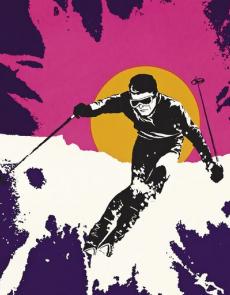SKIING HISTORY
Editor Seth Masia
Managing Editor Greg Ditrinco
Consulting Editor Cindy Hirschfeld
Art Director Edna Baker
Editorial Board
Seth Masia, Chairman
John Allen, Andy Bigford, John Caldwell, Jeremy Davis, Kirby Gilbert, Paul Hooge, Jeff Leich, Bob Soden
Founding Editors
Morten Lund, Glenn Parkinson
To preserve skiing history and to increase awareness of the sport’s heritage
ISHA Founder
Mason Beekley, 1927–2001
ISHA Board of Directors
Rick Moulton, Chairman
Seth Masia, President
Wini Jones, Vice President
Jeff Blumenfeld, Vice President
John McMurtry, Vice President
Bob Soden (Canada), Treasurer
Richard Allen, Skip Beitzel, Michael Calderone, Dick Cutler, Wendolyn Holland, Ken Hugessen (Canada), David Ingemie, Joe Jay Jalbert, Henri Rivers, Charles Sanders, Einar Sunde, Christof Thöny (Austria), Ivan Wagner (Switzerland)
Presidential Circle
Christin Cooper, Billy Kidd, Jean-Claude Killy, Bode Miller, Doug Pfeiffer, Penny Pitou, Nancy Greene Raine
Executive Director
Janet White
janet@skiinghistory.org
Membership Services
Jamie Coleman
(802) 375-1105
jamie@skiinghistory.org
Corporate Sponsorships
Peter Kirkpatrick
(541) 944-3095
peterk10950@gmail.com
Bimonthly journal and official publication of the International Skiing History Association (ISHA)
Partners: U.S. Ski and Snowboard Hall of Fame | Canadian Ski Museum and Hall of Fame
Alf Engen Ski Museum | North American Snowsports Journalists Association | Swiss Academic Ski Club
Skiing History (USPS No. 16-201, ISSN: 23293659) is published bimonthly by the International Skiing History Association, P.O. Box 1064, Manchester Center, VT 05255.
Periodicals postage paid at Manchester Center, VT and at additional mailing offices. Postmaster: Send address changes to ISHA, P.O. Box 1064, Manchester Center, VT 05255
ISHA is a 501(c)(3) public charity. EIN: 06-1347398
Written permission from the editor is required to reproduce, in any manner, the contents of Skiing History, either in full or in part.
Grouse Mountain, British Columbia
After a century, it's still the peak of Vancouver.
Settlers to the young city of Vancouver at the end of the 19th century became enthralled by the beauty and challenge of an unnamed mountain north of their harbor. The Indigenous people had no name for it, because they made a good living fishing and hunting along the shoreline and rarely ventured into the hills. Perhaps only because no one seemed to have climbed it, some believed the mountain unclimbable. On October 5, 1894, the intrepid Sydney Williams proved them wrong and became the first European to climb to the top. For good measure, he returned a week later with three other adventurers, one of whom shot a blue grouse. From then on, despite later efforts by civic officials to change its name to Mount Vancouver, the peak was known as Grouse Mountain.
Photo above: In 1976, the 100-passenger Skyride red tram opened, instantly becoming Grouse’s signature experience.
Williams’ expeditions attracted media attention and the peak became a local landmark. One night in 1902, the city of Vancouver turned off its street lights so that residents could better see a huge bonfire built by climbers on Grouse’s summit. Today, The Cut ski run and the Peak chair are always lighted at night and can be seen from as far south as Bellingham, Washington, a two-hour drive south.
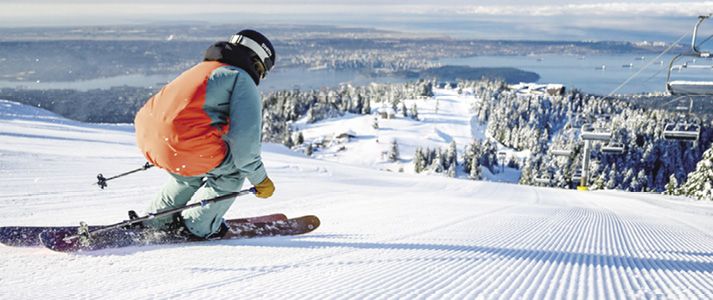
Mountain photo.
The Indigenous people may or may not have climbed it, but the mountain had a place in their legends. A dream story, retold in the 1911 book The Lost Island by Coast Salish writer Pauline Johnson, foretold the colonization of the region by settlers arriving in Vancouver from all parts of the world. In this myth, a troubled shaman climbs to the top of Grouse Mountain, where he fasts and camps for three days. He looks down on the forests, rivers and small settlements where the White Man lives and is granted a vision into the future where the trees are cut down, streets are laid out in a perfect grid, and people live and work, packed into tall concrete towers. The shaman’s premonition eerily describes the view that Grouse’s 1.5 million annual visitors see as they peer down on the city.
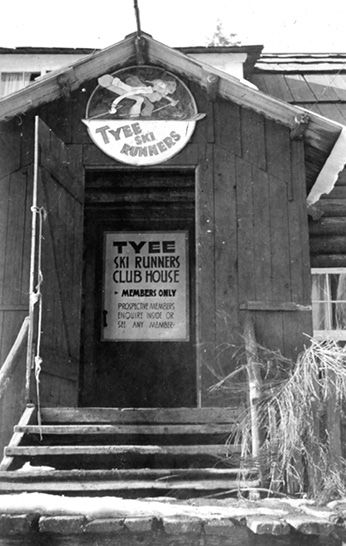
founded in 1929. Photo: Grouse
Mountain Ski Club.
At the turn of the 20th century, reaching the 4,000-foot summit from town required a harbor traverse by ferry, a streetcar ride across North Vancouver, an overnight stay in a ramshackle “base camp” shelter owned by a local printer and a stout hike upward among giant cedars and fir trees.
Schemes abounded to take advantage of Grouse’s airy outpost and, as an early brochure indicates, its “year-round snow.” In 1910, plans were laid for an Alpine-style cog railway to wind up the mountain’s forested slopes to access a deluxe hotel. There was even a scheme to install the world’s most powerful telescope. World War I derailed those ideas, but in 1926, an automobile toll road opened to appeal to a new leisure class. Scandinavian loggers began felling giant trees to make a rudimentary ski trail called, quite descriptively, The Cut. The Grouse Mountain Lodge was finished a short time later, and by 1935, more than a hundred small ski shacks were scattered across the mountain. Lift skiing arrived in 1949 with the erection of the third chairlift in all of Canada. In 1966, a new tramway, the blue Skyride, opened. In 1976, the red Skyride tram launched, which made Grouse Mountain’s aerial tramway system the largest in North America.
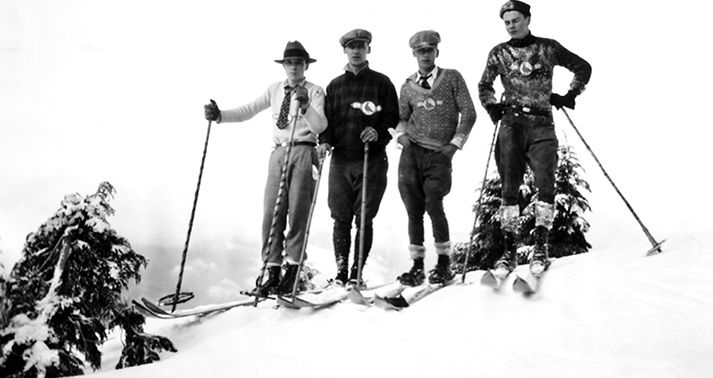
The club merged with Tyee in the 1950s.
GMSC photo.
Along with Stanley Park, Granville Island and the nearby Capilano Suspension Bridge, Grouse Mountain is now a can’t-miss destination for visitors to Vancouver. The Skyride is as famous in its own way as Barcelona’s Montjuic cable car or the Palm Springs Aerial Tramway and the numerous trams and cog railways of the Swiss Alps. On a clear day, keeping in mind that Vancouver averages 200 days of rain annually, visitors enjoy a 360-degree panorama encompassing downtown’s concrete canyons; the verdant forest canopy of Stanley Park; the flat, fertile farms of the Fraser Valley; Mount Baker, the San Juan Islands and the Olympic Mountains in Washington; the blue-black waters of the Salish Sea; and the breathtaking spine of Vancouver Island.
Historically, Grouse’s financial fortunes have been a mixed bag. The hill’s original owners went bankrupt during the Great Depression and the City of Vancouver took over its operation until local newspaper barons the Cromie family added Grouse to their business portfolio in 1953.
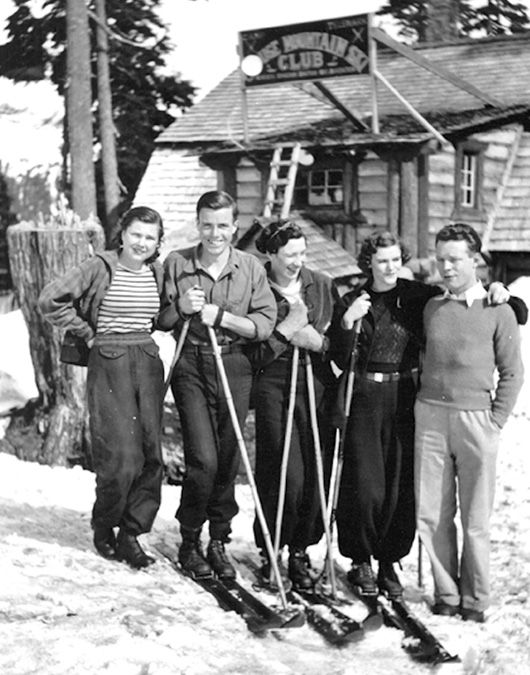
Grouse Mountain truly established itself as a four-season tourism brand under the ownership of the McLaughlin family, from 1989 to 2017. Tens of thousands of cruise ship passengers flooded into the city for 16 weeks each summer, and a huge new convention center built for the 2010 Winter Olympics drew big crowds for events like TED conferences. Thus was created a ready-made audience, and Grouse obliged with numerous summer activities. The mountain hosts everything from zip-lining and Indigenous storytelling to nature programs (performing owls and eagles, a grizzly sanctuary), ropes courses and helicopter tours.
In the early 1990s, endurance athletes started training on a ridiculously steep hiking trail that became known as the Grouse Grind. Rising 800 meters (2,624 vertical feet) in 2.5 kilometers (1.55 miles), the Grind fell into the must-do category for outdoor adventurers within five years. Grouse Mountain marketers promote it as “Mother Nature’s Stairmaster.” The success of the Grouse Grind has, alas, led to the odd wayward hiker needing help courtesy of the North Shore Rescue team, whose staging area for many mountain missions is the nearby heli-pad at Capilano Reservoir.
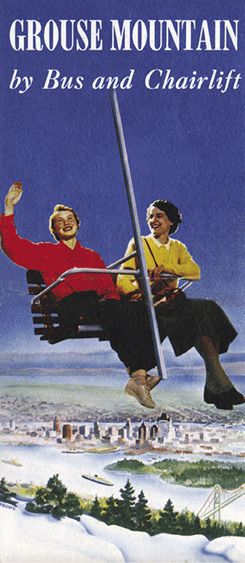
promoted by summer bus tours.
The Cut ski run is Grouse Mountain’s most visible slope, especially when it’s covered in fresh snow or lit up at night. In the 1950s, the Vancouver Sun co-sponsored ski lessons for beginners; during the ’60s, the Grouse Mountain rental shop and ski school were in the vanguard of the Headway learn-to-ski program (akin to the Graduated Length Method). Beginning in 1966, ski school director Ornulf Johnsen guaranteed that novice skiers would be able to ski the Cut after participating in the learn-to-ski program—and offered unlimited lessons until that skill level was achieved. Though the run faces south and lies at an elevation where snow can turn to rain, an efficient snowmaking system ensures that The Cut is well groomed and provides the perfect surface for learning. A well-manicured terrain park has its own lift to ensure that New Schoolers and novices are kept separate.
The really interesting Grouse skiing is over on the east face, where the Olympic Express chairlift feeds approximately 1,200 vertical feet of surprisingly good fall-line skiing. Bring your fat skis after a fresh dump to glide through glades studded by old-growth fir and cedars. In the ’70s, some of Canada’s top freestyle skiers danced down mogul runs like Hades, Purgatory and Inferno, and the mountain hosted Canada’s first World Cup freestyle skiing championship in 1978.
During the 2010 Winter Games, Grouse neatly outfoxed its rival Cypress Mountain (site of the freestyle skiing and snowboarding events) by hosting NBC’s Today Show for the duration of the event.
Because Grouse has such a diversified portfolio of four-season, on-mountain activities, the learn-to-ski lesson package and season’s pass are quite affordable. The Skyride red tram hauls skiers from the parking lot to the Observatory day lodge (formerly the Grouse Nest), and on midweek evenings passengers chatter in a cacophony of languages. You’ll meet German, Spanish and Italian exchange students—many of them expert skiers—shoulder-to-shoulder with recent Asian immigrants, some of whom have never seen snow before. Just six miles south twinkle the lights of a cosmopolitan city of 2.5 million, but Grouse’s location at the edge of North America’s vast wilderness is captivating, whether you’re carving up fresh corduroy or snowshoeing a nature trail. Grouse also serves as home base for one of Canada’s largest adaptive skiing programs. Moreover, since 1929, thousands of skiers have trained for races hosted by the Grouse Mountain Tyee Ski Club.
In 2026, Grouse Mountain has big plans to celebrate its centenary. Despite the chill placed on the international tourism industry by Covid, Grouse is proceeding with plans to build a high-speed gondola, replacing the blue tram Skyride, which will greatly increase its capacity to handle crowds at peak periods. 
Table of Contents
WORLD CHAMPIONSHIP ($3,000+)
BerkshireEast/Catamount Mountain Resorts
Gorsuch
Warren and Laurie Miller
Sport Obermeyer
Polartec
CHAMPIONSHIP ($2,000)
Fairbank Group: Bromley, Cranmore, Jiminy Peak
Hickory & Tweed
Rossignol
Snowsports Merchandising Corporation
WORLD CUP ($1,000)
Aspen Skiing Company
Atomic USA
Bogner of America
Boyne Resorts
Dale of Norway
Darn Tough Vermont
Dynastar/Lange/Look
Gordini USA Inc/Kombi LTD
Head Wintersports
Intuition Sports
Mammoth Mountain
Marker/Völkl USA
National Ski Areas Association
North Carolina Ski Areas Association
Outdoor Retailer
Ski Area Management
Ski Country Sports
Sports Specialists Ltd
Sugar Mountain Resort
Sun Valley Resort
Vintage Ski World
World Cup Supply
GOLD MEDAL ($700)
Larson's Ski & Sports
Race Place/Beast Tuning Tools
The Ski Company (Rochester NY)
Thule
SILVER MEDAL ($500)
Alta Ski Area
Boden Architecture PLLC
Dalbello Sports
Deer Valley
EcoSign Mountain Resort Planners
Elan
Fera International
Holiday Valley Resort
Hotronic USA/Wintersteiger
Kulkea
Leki
Masterfit Enterprises
McWhorter Driscoll LLC
Metropolitan New York Ski Council
Mt. Bachelor
New Jersey Ski & Snowboard Council
Nils
Russell Mace Vacation Homes
SchoellerTextil
Scott Sports
Seirus Innovations
SeniorsSkiing.com
Ski Utah
Snowbird Ski & Summer Resort
Steamboat Ski & Resort Corp
Sundance Mountain Resort
Swiss Academic Ski Club
Tecnica Group USA
Timberline Lodge and Ski Area
Trapp Family Lodge
Wendolyn Holland
Western Winter Sports Reps Association
World Pro Ski Tour


